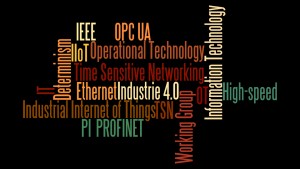At the end of last year, PI (PROFIBUS & PROFINET International) established a new “I4.0” working group with the goal of preparing use cases relevant for Industrie 4.0 from the perspective of industrial communication. On this basis, existing and new technologies will be assessed from the standpoint of use in Industrie 4.0 production systems and the standardization environment will be analyzed. The working group will identify requirements for communication that are important in the Industrie 4.0 environment and bring them to standardization consistently as further development of PI technologies.
 As one of the first results, a new sub-project is now being started for specific measures for the merging of IT (Information Technology) and OT (Operations Technology). IT networks and production networks are increasingly growing together. In the past, however, they were always identified by different characteristics. For example, IT networks mainly handle large bandwidths and connect different locations, while production networks mainly feature high performance and short latencies. With TSN (Time Sensitive Networking), technologies are now being developed in the IEEE that will connect the bandwidth of IT networks with the latency of OT networks.
As one of the first results, a new sub-project is now being started for specific measures for the merging of IT (Information Technology) and OT (Operations Technology). IT networks and production networks are increasingly growing together. In the past, however, they were always identified by different characteristics. For example, IT networks mainly handle large bandwidths and connect different locations, while production networks mainly feature high performance and short latencies. With TSN (Time Sensitive Networking), technologies are now being developed in the IEEE that will connect the bandwidth of IT networks with the latency of OT networks.
A distinction of PROFINET is that it relies on standard IT technology while satisfying stringent real-time requirements. PI sees a large opportunity to combine the strengths of PROFINET and TSN and to generate further added value from this for customers, thereby setting PROFINET on a future-oriented foundation for Industrie 4.0. The combination will also yield versatile use of new TSN-capable standard Ethernet blocks for manufacturers of PROFINET devices. Proven PROFINET services, profiles, and user interfaces, such as diagnostics, alarms, PROFIsafe, and PROFIdrive remain unchanged for the user. PROFINET already provides a very good starting position for the use of TSN mechanisms. The convergence of real-time-capable traffic with IP-based traffic, which will increase significantly in Industrie 4.0 applications, is already firmly anchored in the PROFINET architecture today. In addition, new ideas discussed in the IEEE, such as establishment of real-time-capable dynamic ad-hoc connections, can be integrated. PROFINET is thus a consistent participant in the further development in the IEEE.
For this reason, PI will actively advance the further development of TSN and point out ways this technology can be used in PROFINET networks. In doing so, special attention will obviously be given to a seamless transition for today’s installations so that users have an easy path to TSN-based networks. First results of the working group can be expected at SPS/IPC/Drives 2016.
Other topics such as the use of OPC UA and expanded access to asset management data are also needed for implementation of Industrie 4.0 applications and are being actively advanced by the I4.0 working group.
